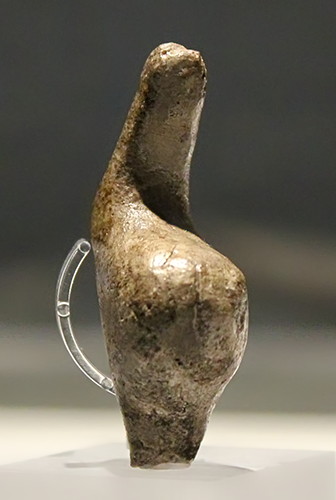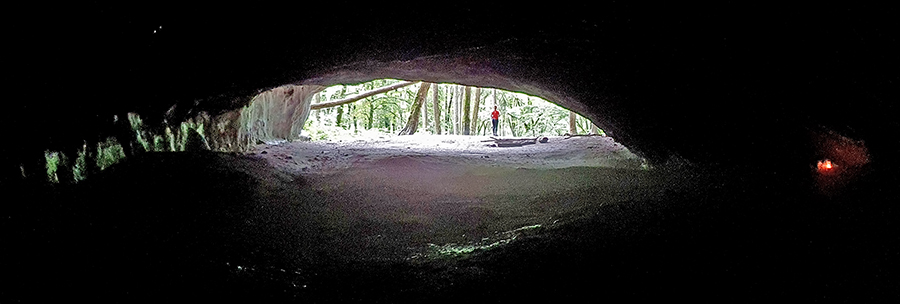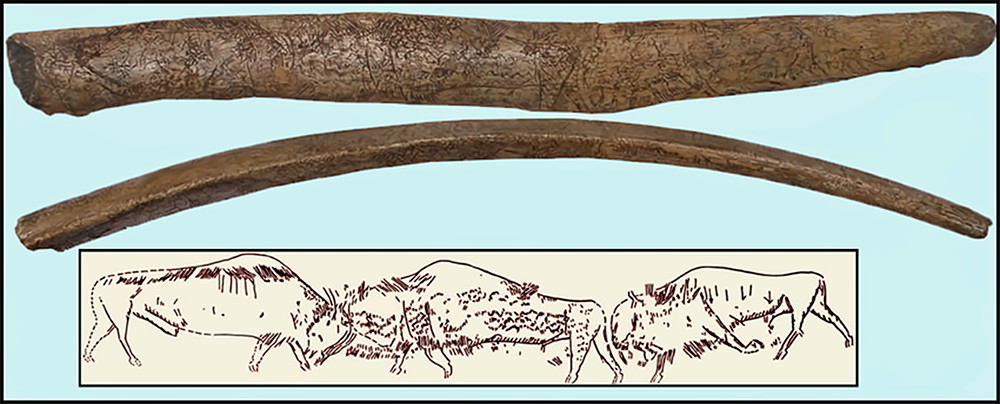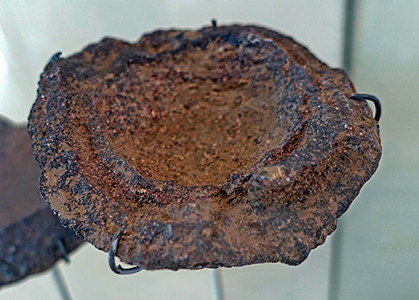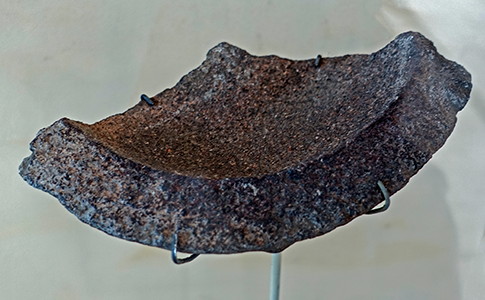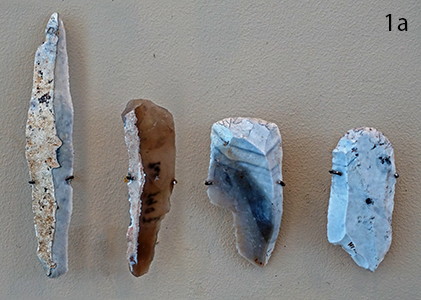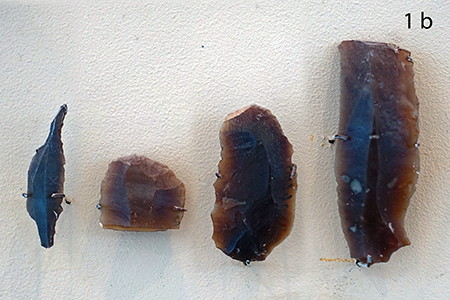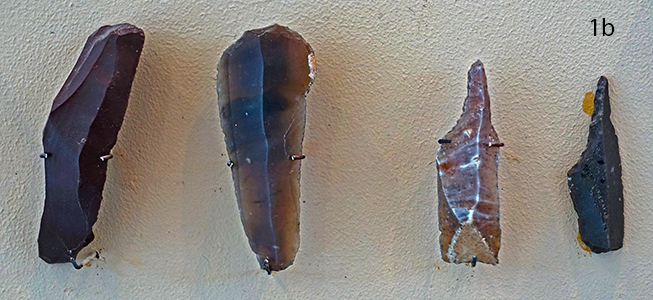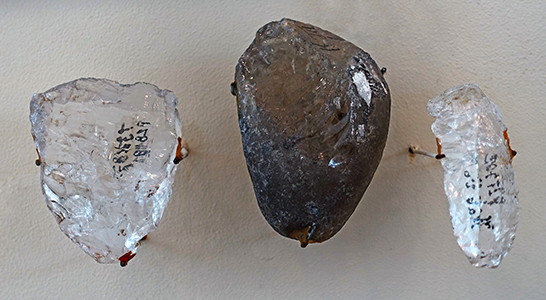Back to Don's Maps
Back to Venus figures from the Stone Age
 Back to Central European Sites
Back to Central European Sites
Venus of Pekarna

Pekarna Cave
Photo: Courtesy Tomasz, 2021
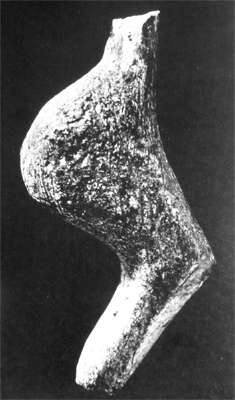
The Venus of Pekarna (Moravia), ~14 500 BP
This venus is obviously from the same tradition as that of the Gönnersdorf and Lalinde venus figures.
Photo: Marshack (1972)
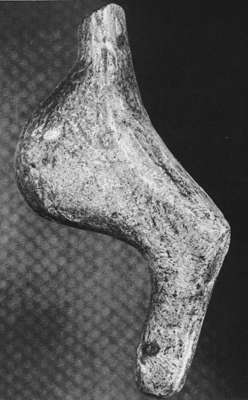
The Venus of Pekarna (Moravia)
Photo: Müller-Beck and Albrecht (1987)
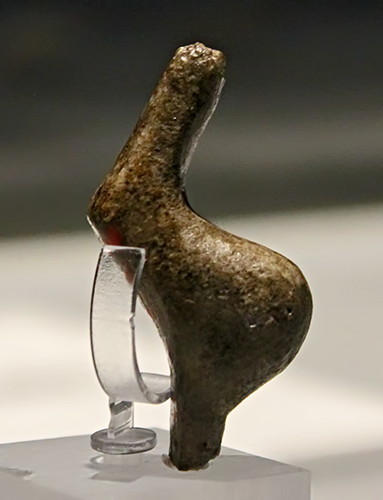
Venus of Pekarna
( Note that this piece is exhibited upside down compared to the images above. The latest displays of the piece all have this orientation, with the long 'neck' uppermost - Don )
Photo: Ralph Frenken
Source: Facsimile, exhibited at the Archeological Museum Hamburg (Ice Age - The Art of the Mammoth Hunters from 18 October 2016 to 14 May 2017)
On loan from the Hermitage Museum, Saint Petersburg, Russia.
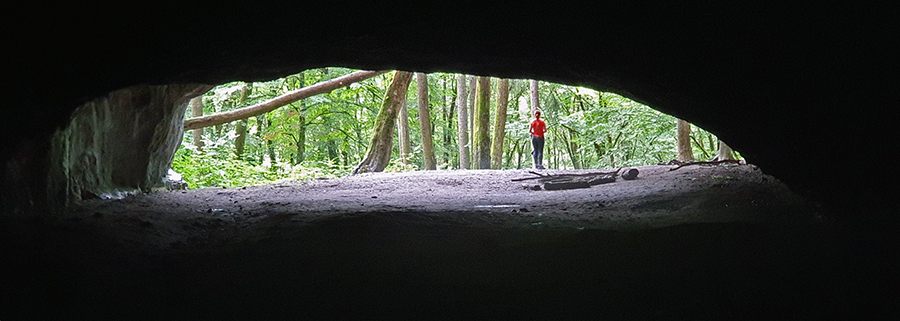
Pekarna Cave
Photo: Courtesy Tomasz, 2021
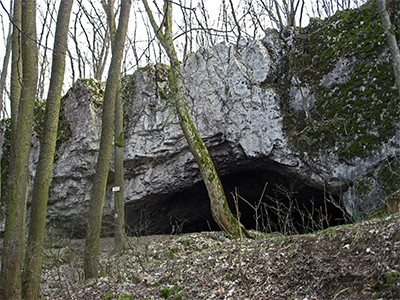
Pekarna Cave
Photo: Dezidor
Permission: Creative Commons Attribution 3.0 Unported license.
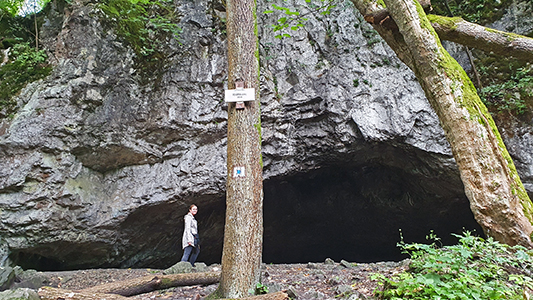
Pekarna Cave
Photo: Courtesy Tomasz, 2021

Map showing the location of the cave.
The Czechoslovak Republic in 1918–1938 within European context. On the enlarged map one can see the historical frontier between Bohemia and Moravia with marked main sites commented in the text (the area depicted corresponds with today’s Czech Republic; 1 – Dolní Věstonice, 2 – Pekárna Cave, 3 – Býčí skála Cave, 4 – Ondratice, 5 – Otaslavice, 6 – Předmostí u Přerova, 7 – Ostrava- Petřkovice).
Frontier areas are marked in grey – so-called 'Sudety' – which became part of Germany from 30.09.1938 to 9.05.1945 due to the 'Munich Agreement'. The reduced territory existed from 30.09.1938 to 14.03.1939 as the so-called 'Second Republic'. From 15.03.1939 to 9.06.1945 this area was changed into the 'Protectorate of Bohemia and Moravia'. The Slovak part of the state in the East (indicated only on the downscaled map of Europe) became an independent republic.
Photo: after Kostrhuna (2009)
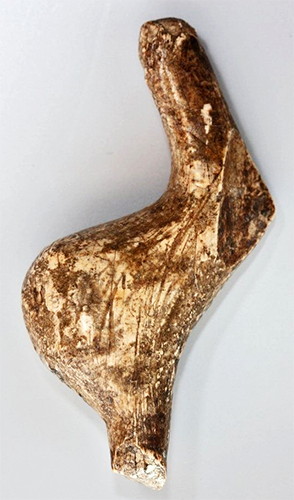
Venus of Pekarna
Photo: ces.mkcr.cz
Pekárna is a large tunnel cave in the southern part of the Moravian Karst, in the cadastral area of Mokrá near Brno (part of Mokrá-Horákov), 1.5 km southeast of the village of Ochoz u Brna, 11 km NE of Brno.Text above: https://www.outdooractive.com/en/poi/brno-venkov/pekarna-cave/35712035/
With its 6 m high and 23 m wide portal, it opens into the Říčka Valley. It represents an important archaeological site. The cave is made up of a single 64 m long corridor, which is almost wholly lit by daylight. The end of the cave is formed by a large boulder cave under the chimney. The entrance to the cave is 5 metres high and 20 metres wide and its shape resembles a massive bread oven. As a result of its entrance, the cave was named Pekárna (Bakery in english).
Pekárna Cave is important in terms of bats occurring outside the winter season.

Venus of Pekarna
Mammoth ivory, height 45 mm, width 17 mm thickness 14 mm, discovered 1927
Photo: © Vít Lang, http://www.lands-of-venuses.eu/v-b-pekarna/w-b-pekarna.html
Source: Facsimile, Dolni Vestonice Museum
(Original at Anthropos, Moravské zemské muzeum, Brno)
Spatula or spoon, perhaps a serving dish, made from the jaw of a horse.
Decorated with what may be an ibex and an aurochs or bison (inverted) on the top image, and horses on the reverse side, see below.
Photo: Don Hitchcock 2018
Source: Facsimile, Anthropos Pavilion/Moravian Museum, Brno, Czech Republic
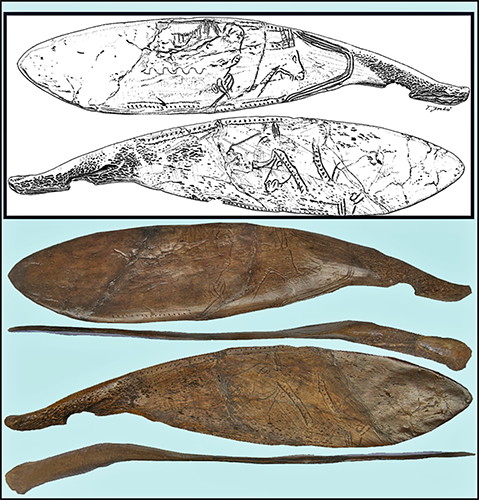
This valuable image shows both sides of the spatula above, with drawings of the images engraved on it.
Artist and photographer: Unknown
Source: © http://www.biologus.eu/Pekarna.html
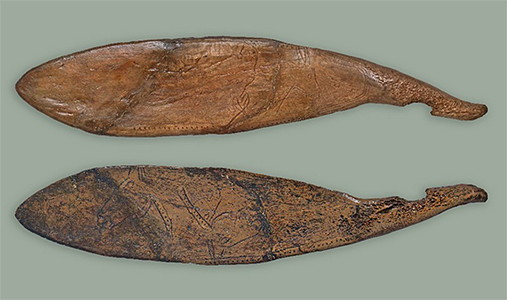
Engravings of horse heads, antelopes and bison on a horse jaw bone, from Pekarna Cave
( note that the lower image, apparently of the reverse side of the piece, does not match up with that shown above from http://www.biologus.eu/Pekarna.html. The horse heads face in different relative directions. One of the two has not been correctly reproduced - Don )
Photo: © Ivan Balak
Source: http://www.cittadella.cz/europarc/index.php?p=index&site=NPP_jeskyne_pekarna_en
A spatula or spoon, perhaps a serving dish, made from the jaw of a horse.
Decorated with the image of a horse.
Photo: Don Hitchcock 2018
Source and text: Facsimile, Anthropos Pavilion/Moravian Museum, Brno, Czech Republic

This valuable image shows both sides of the spatula above, with drawings of the images engraved on it.
Artist and photographer: Unknown
Source: © http://www.biologus.eu/Pekarna.html
Pekarna Cave from inside, looking towards the entrance.
Photo: Courtesy Tomasz, 2021
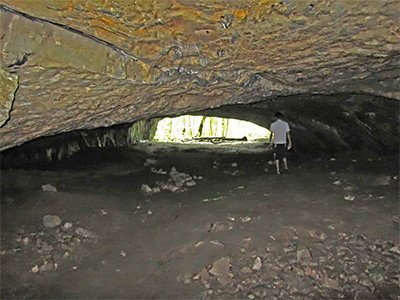
Pekarna Cave from deep inside, looking towards the entrance.
The cave is formed by a single 64 m corridor which is lit by daylight. The end of the cave is created from a large boulder pile under the shaft.
Karel Absolon performed research here and proved it had been settled in Palaeolithic times. Famous findings include engravings by a Magdalenian artist of the 'Duel of the bisons' and 'Grazing horses' carved on horse ribs.
Text: © Jeskyně Pekárna, http://www.south-moravia.info/ochoz-u-brna/13_3469_pekarna-caves-national-natural-heritage-area/
GPS: 49°14'31.12"N 16°44'46.16"E
360 m above sea level
Photo: adistroyer
Source: https://www.panoramio.com/photo/63014314
Permission: Creative Commons Attribution-Share Alike 3.0 Unported license
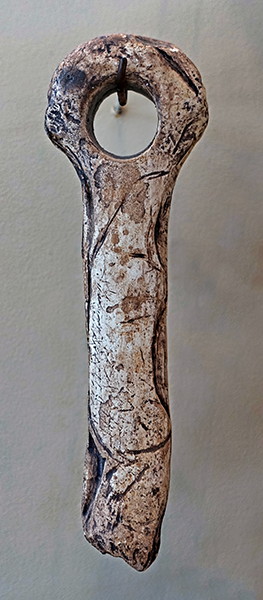
Pierced baton.
( it appears to have a carved representation of an animal, possibly a bear, on it - Don )
Photo: Don Hitchcock 2018
Source: Facsimile, Anthropos Pavilion/Moravian Museum, Brno, Czech Republic
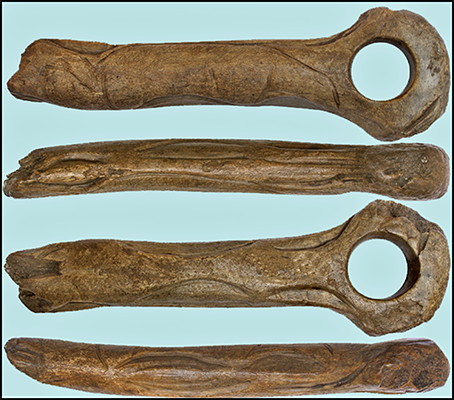
These four images shows all sides of the pierced baton above.
Photographer: Unknown
Source: © http://www.biologus.eu/Pekarna.html
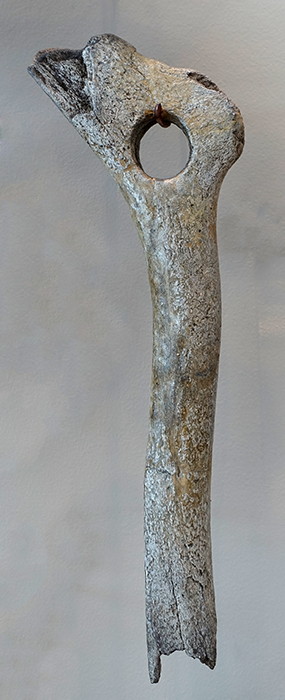
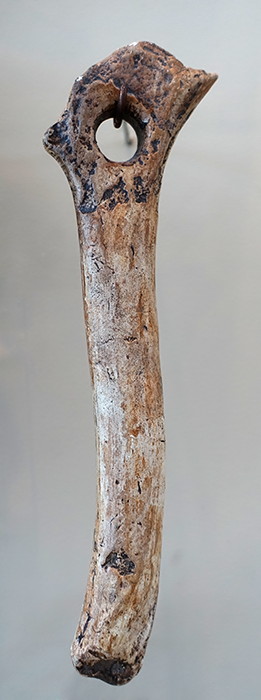
Pierced batons.
(left) Original.
(right): Facsimile.
( both are undecorated - Don )
Photo: Don Hitchcock 2018
Source: Original, Anthropos Pavilion/Moravian Museum, Brno, Czech Republic
Engraved bone showing bisons fighting.
Photo: Don Hitchcock 2018
Source: Facsimile, Anthropos Pavilion/Moravian Museum, Brno, Czech Republic
The engraving above is of bisons fighting, as shown here.
( the bone is a horse rib. - Don )
Artist and photographer: Unknown
Source: © http://www.biologus.eu/Pekarna.html
Engraved bone showing four horses grazing.
Photo: Don Hitchcock 2018
Source: Facsimile, Anthropos Pavilion/Moravian Museum, Brno, Czech Republic
Photo and drawing of the engraved bone shown above.
Artist and photographer: Unknown
Source: © http://www.biologus.eu/Pekarna.html
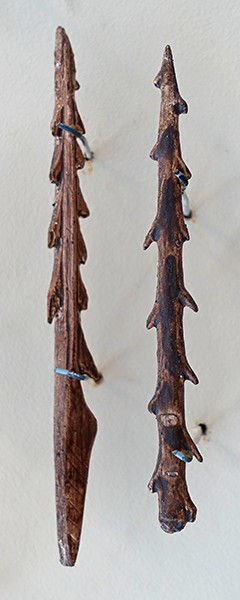
Two harpoons.
( The harpoon head on the left is curious. It has four bevels, arranged in pairs at right angles to each other. If a socket to fit it could be carved, it would certainly be solidly attached to the spear shaft.
However it is difficult to see how such a socket could be easily made. It is more likely that it was designed to fit into a two sided fork on the end of the spear shaft, but that it could be oriented one way or the other, at right angles.
The only reason I can think of for this flexibility of orientation may be regarded as fanciful, but perhaps it was designed in that manner so that it would slide between the ribs of animals and fish if the barbs were vertical when launched by a spear thrower, and at right angles to the fletching, but if the object was warfare, the flukes would be oriented to enter the body horizontally to slide between the ribs of humans, in the same plane as the fletching.
A more prosaic reason might be that the harpoon head was only ever put in one way, but that the extra bevels were there simply to reduce the thickness of the base of the harpoon, so that it and some part of the spear shaft might more easily enter the body of the prey. In which case, the fork in the shaft of the spear would have been on the left and right of the image shown, since this is where the artisan has put rough grooves to help adhesion using birch bark glue - Don )
Photo: Don Hitchcock 2018
Source: Facsimile, Anthropos Pavilion/Moravian Museum, Brno, Czech Republic
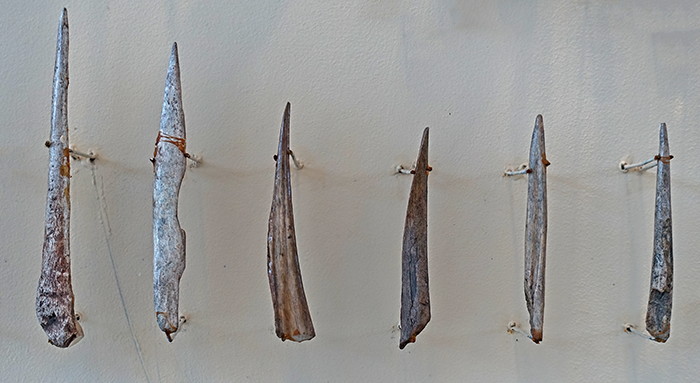
Poinçons, awls, used for making holes in leather so that skins could be sewn together using needles and sinew or cord to make clothes and other articles.
Photo: Don Hitchcock 2018
Source: Original, Anthropos Pavilion/Moravian Museum, Brno, Czech Republic
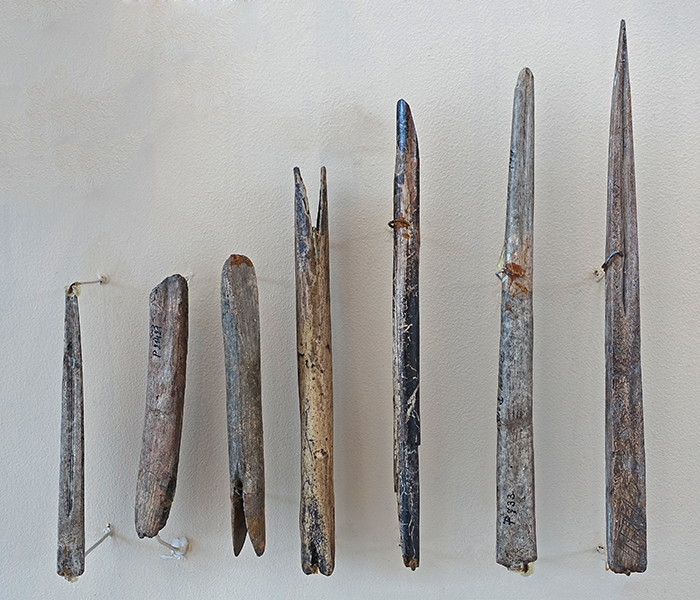
This is a curious collection of bone artefacts.
The object on the left, and the two on the far right, appear to be a type of spear point, attached by a double bevel to the spear shaft, itself cut into a corresponding fork, but the points having been 'beveled' as well over most of their length, and with a groove cut into the middle, towards the point, perhaps to let blood flow freely. They may have been made using rib bones, since they are thin and flat (quasi - rectangular) in cross section.
The remaining four objects appear to be 'extensions' of the spear shaft, perhaps to restore the correct length after damage to the original shaft. Those second, third, and fourth from the left are forked and double beveled, whereas the fifth from the left has a single bevel on one end, and what may be a fork on the other.
Photo: Don Hitchcock 2018
Source: Original, Anthropos Pavilion/Moravian Museum, Brno, Czech Republic
Text: Don Hitchcock

Plan of Pekarna Cave, with the locations of various finds.
Artist: Unknown
Rephotograpy: Don Hitchcock 2018
Source: Poster, Anthropos Pavilion/Moravian Museum, Brno, Czech Republic
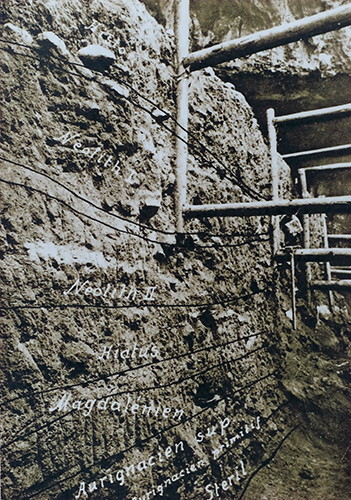
A coupe, a cross section, of deposits apparently just outside the present entrance to the cave, with the various layers named, from the Early Aurignacian to the Neolithic.
Note the bracing to avoid collapse of the trench.
The photograph is also remarkable for the pre-Photoshop methods of marking the photo using the (possibly glass*) negative - the black lines are where the emulsion was scraped away entirely, using a needle or burin or similar point, allowing light unimpeded access to the print, while the white writing was done using any light-opaque ink, black or white or coloured, which results in light being unable to pass through it, resulting in white writing when the print is developed. The photograph has been sepia toned after printing, which extends the life of the print considerably.
*Glass negatives were regarded as superior to film for serious academic work, since they were not as likely to bend or distort as film was. They were used for astronomy until very recent times, even into the 1990s, until digital imagery improved enough to replace glass negatives.
Photo: Unknown, but probably Archives of the Anthropos Institute, Moravian Museum
Rephotography: Don Hitchcock 2018
Source: Poster, Anthropos Pavilion/Moravian Museum, Brno, Czech Republic
Text: Don Hitchcock
Fat Lamps quickly fashioned from ferruginous nodules which fortuitously had a natural bowl shape, ideal for the purpose.
Photo: Don Hitchcock 2018
Source and text: Original, Anthropos Pavilion/Moravian Museum, Brno, Czech Republic
Additional text: Don Hitchcock
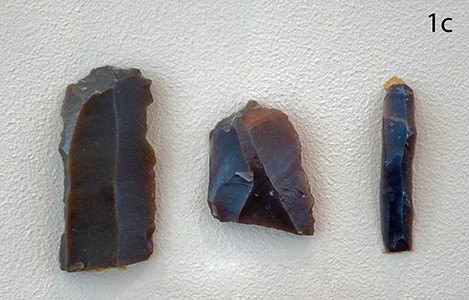
Most raw materials for the lithic industry of Pekárna Cave have their origin in glacial deposits in Silesia, at least 100 Km to the north (1a).
Rarely, the Jurassic siliceous material from Krakov (1b, 250 km away), and the chocolate coloured cherts of the Świętokrzyskie (Holy Cross) Mountains (1c, over 350 km away) were used.
Photo: Don Hitchcock 2018
Source and text: Original, Anthropos Pavilion/Moravian Museum, Brno, Czech Republic
In the lithic industry of the Pekárna Magdalenian, backed blades are predominant.
Amongst other retouched tools are burins designed to be used on antlers and bones, with a fewer number of scrapers.
Also typical are drills.
Photo: Don Hitchcock 2018
Source and text: Original, Anthropos Pavilion/Moravian Museum, Brno, Czech Republic
Artefacts in rock crystal (crystalline quartz) brought from the highlands of Czechoslovakia.
The piece in the centre has been gathered from a stream bed, and is of a type of smoky quartz known in English as Cairngorm.
Photo and additional text: Don Hitchcock 2018
Source and text: Original, Anthropos Pavilion/Moravian Museum, Brno, Czech Republic
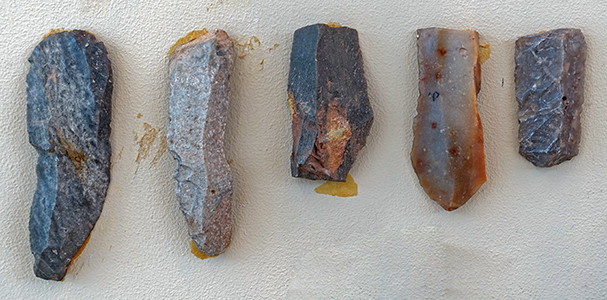
Raw materials of local origin, especially from Cretaceous and Jurassic limestone layers, were the ones used most commonly.
Photo: Don Hitchcock 2018
Source and text: Original, Anthropos Pavilion/Moravian Museum, Brno, Czech Republic

Unprocessed amber reveals contact with the Baltic coast.
Photo: Don Hitchcock 2018
Source and text: Original, Anthropos Pavilion/Moravian Museum, Brno, Czech Republic
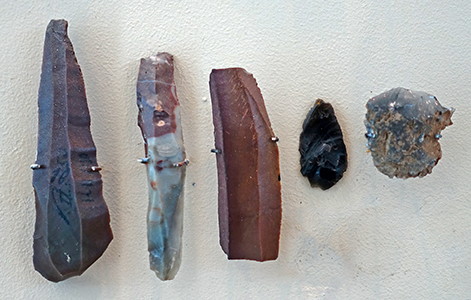
The import of the Carpathian radiolarites (chert-like material, containing fossil radiolarites) from the east, at least 100 km away continued, but rarely was the eastern Slavic obsidian (i.e. Pekárna and Kůlna) used. (Kůlna Cave is situated 35 km north of Brno).
These samples originate from a different cultural environment.
Photo: Don Hitchcock 2018
Source and text: Original, Anthropos Pavilion/Moravian Museum, Brno, Czech Republic
Southern entrance of Kůlna Cave.
Photo: P. Neruda
Source and text: Neruda (2010)
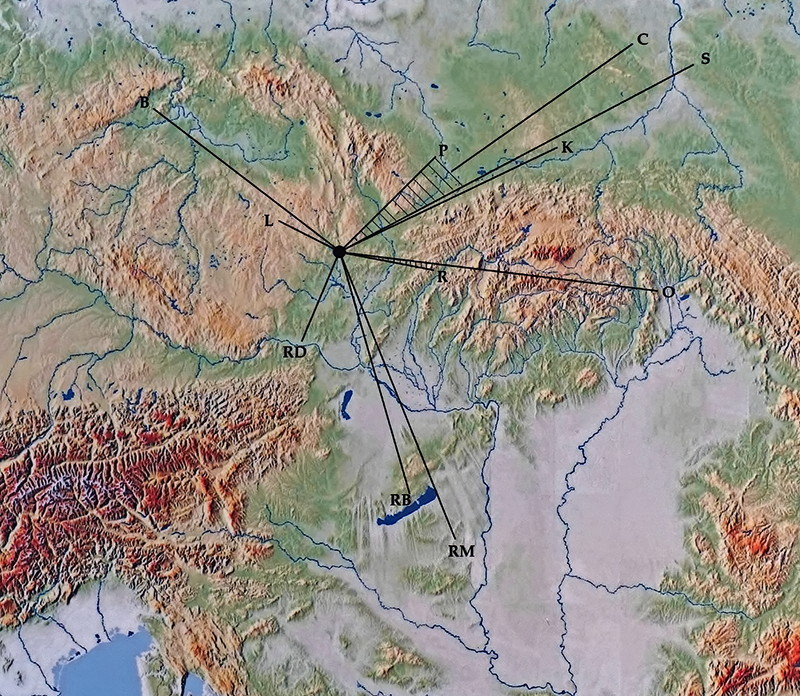
Flint sources for the inhabitants of Pekárna Cave and sites close by.
If we map out the geographical extension of the sites, it would seem that Magdalenian hunters did not get too far from their karst homeland. However, the raw materials of stone tools show the use of nearby (up to 10 km) as well as very distant (over 100 km distant) sources. If the use of designated raw material sources maps the action radius of the group, then the hunters moved relatively quickly to northern Poland (with flint sources) and to the Carpathians where the radiolarite deposits were located.
( In the following, the names in brackets are the caves or sites in which the particular flint/chert specimens were used - Don )
P Pazourek or flint, R Radiolarit, L Crystal, B bečovský křemenec or bečovský quartz (Brno-Maloměřice ), K podkrakosky silicit, C silicit typu čokoláda, chocolate silica, S swieciechówský silicit (Pekárna), O obsidian (Kůlna), RM radiolarit typu Meczek (J. Ochozská), RB radiolarit z Bakonyského pohoří (Balcarka, Malá Dátenická), RD radiolarit from river gravel, perhaps the Danube? (Balcarka)
Rephotography: Don Hitchcock 2018
Source and text: Poster, Anthropos Pavilion/Moravian Museum, Brno, Czech Republic
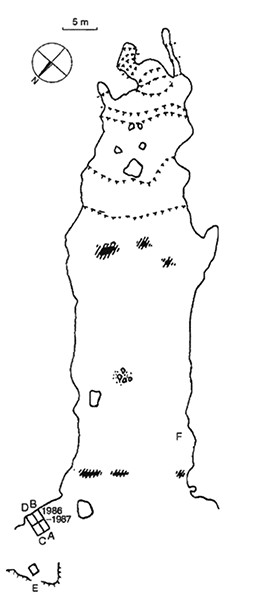
General plan of the Pekárna Cave, showing the location of the excavation 1986-1987 (sections AB, CD, and E) and the location of the radiometrically dated travertine deposit (F)
Photo and text: Horacek (2000)
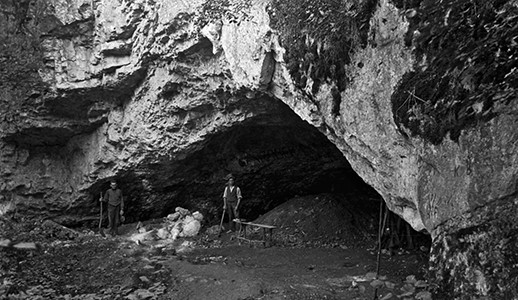
Pekárna Cave at the beginning of Absolon’s research in 1925.
The first excavation campaigns focused on exposures on the left side of the cave as seen from the entry.
Photo: Archives of the Anthropos Institute, Moravian Museum.
Source and text: Kostrhuna (2009)
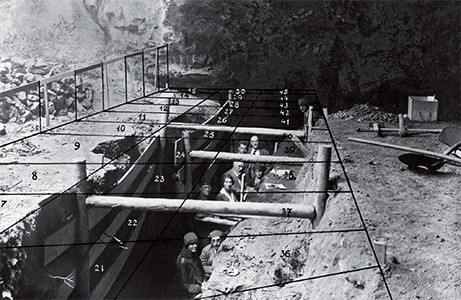
Visit of the American School of Prehistoric Research headed by Grant Mac Curdy in the transverse excavation trench inside the Pekárna Cave on July 22nd, 1926 where the classic Absolon section with all layers was uncovered. On the photo there is an indicated quadratic network.
The other participants in the excursion: Mrs. MacCurdy, dr. Edward Reynolds (Harvard Univesity), Mrs. Reynolds, Mrs. Harriett Allyn (Vassar College), Miss Edna Thuner (director of Liggett School), Mr. Richard M. Bond (Yale University), Mr. Grant T. Wickwire (Wesleyan University), Mr. Robert W. Ehrich (an anthropologist from New York), Henry Field (Dep. of Anthropology, Field Museum, Chicago), Mrs. Mitchell Carroll with son (Smithsonian Institution, Washington). After “Lidové noviny” from July 22nd, 1926.
Photo: Archives of the Anthropos Institute, Moravian Museum.
Source and text: Kostrhuna (2009)
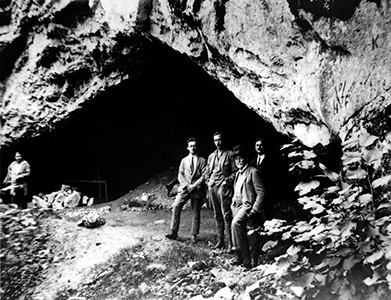
Pekárna cave with distinguished guests: from left, the archaeologist Josef Skutil, Franz Cupik (one of the Brno amateurs of the German nationality) and Jan Knies.
Photo: Unknown, but probably Archives of the Anthropos Institute, Moravian Museum
Rephotography: Don Hitchcock 2018
Source and text: Anthropos Pavilion/Moravian Museum, Brno, Czech Republic
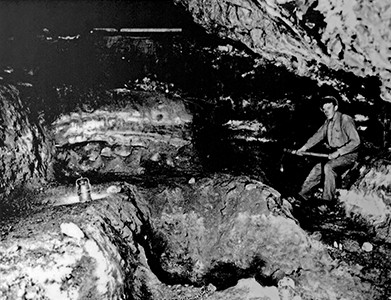
The entrance to Pekárna cave is in a sunny position, in limestone that was precipitated in a very humid climate at the beginning of the Holocene.
Photo: Unknown, but probably Archives of the Anthropos Institute, Moravian Museum
Rephotography: Don Hitchcock 2018
Source and text: Anthropos Pavilion/Moravian Museum, Brno, Czech Republic
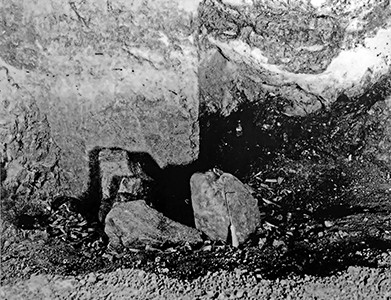
This fireplace was surrounded by stones and lots of broken bones.
( Note the hook with a handle. This was a common tool in archaeology at this time - Don )
Photo: Unknown, but probably Archives of the Anthropos Institute, Moravian Museum
Rephotography: Don Hitchcock 2018
Source and text: Anthropos Pavilion/Moravian Museum, Brno, Czech Republic
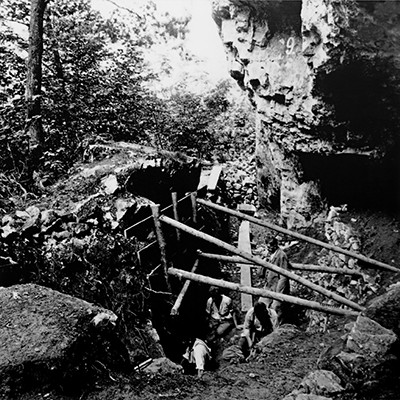
Hazardous research at the eastern edge of the entrance.
( Note the cross bracing in the dig to avoid a collapse of the pit - Don )
Photo: Unknown, but probably Archives of the Anthropos Institute, Moravian Museum
Rephotography: Don Hitchcock 2018
Source and text: Anthropos Pavilion/Moravian Museum, Brno, Czech Republic
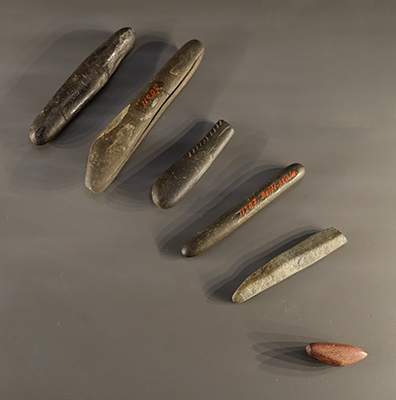
Rods from Býčí skála Cave, as mentioned in the map above, Magdalenian, circa 14 000 BP.
Photo: Don Hitchcock 2018
Source: Museum of Natural History, Vienna
References
- Horacek, I. et al., 2000: The Pekárna Cave. Magdalenian stratigraphy and the termination of the loess formation in Moravian Karst, Antropozoikum, 24 pages, 61-79
- Kostrhuna, P., 2009: Karel Absolon (1877–1960) and the research of significant Palaeolithic sites in Moravia, Archaeologia Polona, vol. 47 : 2009, 91 – 139 PL ISSN 0066 - 5924
- Müller-Beck, H. and Albrecht, G. (Ed.), 1987: Die Anfänge der Kunst vor 30000 Jahren Theiss: Stuttgart.
- Neruda, P., 2010: Economic behaviour and mental capacity of Neanderthals, Research Gate, Article, January 2010
